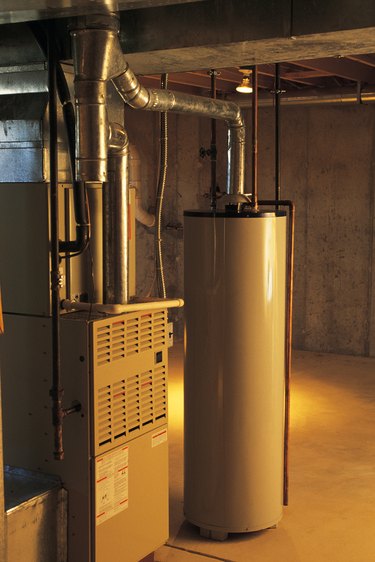
The annual fuel utilization efficiency (AFUE) rating is used to measure a furnace's efficiency. Furnaces today have AFUE ratings of 78 to 96 percent. The Federal Trade Commission (FTC) requires manufacturers to indicate the AFUE on the label of furnaces. Most furnaces for residential use have an AFUE rating of 80, 90 or 95 percent. Those with a rating of 90 or 95 provide the highest efficiency.
90-percent Efficiency
Video of the Day
When a furnace has a 90-percent AFUE, that means it converts 90 percent of its energy to heat. The remaining 10 percent is energy that is lost, or evaporates into the air surrounding the furnace or goes up the chimney. This is why it is important to know the AFUE rating when you shop and compare furnaces. It is also important to keep in mind that energy loss is expected, and takes place with any type of furnace. You should also factor in your climate when assessing and selecting a furnace based on the AFUE. For example, if you live in the South, where winters are relatively mild, a 90-percent — or in many cases even an 80-percent — furnace will provide adequate warmth for your home.
Video of the Day
95-percent Efficiency
A furnace with a 95-percent AFUE efficiency converts 95 percent of its energy to heat. Furnaces with an AFUE above 90 percent operate as condensing furnaces. This means that the furnace condenses escaped water vapors and converts them back to energy and heat. As a result, the furnace is more efficient than a noncondensing furnace because it has the ability to recapture lost heat. This is an important consideration if you live in a cold climate, such as areas of the Northeast and the Midwest where winters are frigid. You will appreciate the extra 5-percent efficiency of a furnace with a 95-percent AFUE so you can keep as much heat inside of your home as possible, instead of allowing it to escape outdoors.
Cost Comparison
If you are upgrading to a 90- or 95-percent furnace from an older furnace with a 70-percent AFUE, you are in for significant savings on your energy bills. According to the American Council for an Energy-Efficient Economy, you will save $22 for every $100 you spend on gas or oil by upgrading to a 90-percent furnace. You will save $26 for every $100 you spend if you upgrade to a furnace with a 95-percent AFUE. So if you spend $1,200 each year on gas heating, your total savings would be $264 with a 90-percent AFUE furnace, and $312 with a 95-percent AFUE.
Return on Investment Comparison
To calculate your return on investment, divide your first year's saving by your investment — furnace cost plus insulation cost. As an example, let's use the 95-percent AFUE furnace that generates a savings of $312. If the investment cost is $2,000, the return on investment is 15.6 percent. When you consider that a furnace can last up to 20 years, the 95-percent AFUE furnace would pay for itself in about six and a half years (2,000 divided by 15.6). If the investment cost for a 90-percent furnace was $1,800, it would pay for itself in about six and three-quarter years. Use these examples to calculate costs and savings with your current furnace and prices for 90- and 95-percent furnaces in your area.